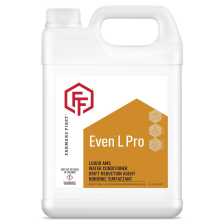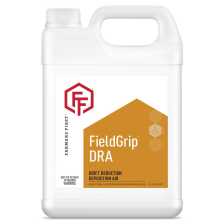Adjuvants 101: Understanding the “Extras” in Your Tank
When it’s time to apply an herbicide, or maybe a pesticide, insecticide or fungicide, you want to ensure you’re getting the most out of every droplet that leaves the sprayer.
Are you including an adjuvant in your tank mix? How do you know if you should?
Watch Video: Mastering Adjuvants
Dr. Mitch Roth, FBN® regional agronomist, explains how to maximize the effectiveness of your crop protection with adjuvants in this webinar.
What Is an Adjuvant?
An adjuvant is a non-pesticide product added to a spray tank mix that enhances the performance of the spray solution. They often improve spray mix characteristics – such as spreading, penetration or droplet size – or reduce any potential application problems from the spray mix itself, thus increasing effectiveness. Examples of adjuvants include surfactants, oils, buffers, and defoaming agents.
Spray adjuvants can be categorized into two groups:
Activator adjuvants
Special purpose adjuvants
Activator Adjuvants
Activator adjuvants improve the action of a pesticide product by encouraging absorption and efficacy. This category of adjuvants includes:
Surfactants
Oils
Nitrogen-based fertilizers
Surfactants
Surfactants change the surface tension of a spray droplet. They make the area of pesticide coverage larger, increasing exposure to the chemical. These are useful when applying a pesticide to a plant with waxy or hairy leaves.
Some commonly used surfactants include:
Nonionic Surfactants: Compatible with most pesticides - Help pesticide sprays penetrate plant cuticles - Are recommended for most pesticides that require a surfactant
Organo-silicone Surfactants: Reduce surface tension, increase spreadability and improve rainfastness
Oils
Crop oils promote the penetration of a pesticide spray either through a plant's waxy cuticle. Two commonly used variations are:
Crop oil concentrates (COCs) have the penetration of an oil with the spread of a surfactant. COCs are often used with post-emergence herbicides.
Vegetable oil concentrates (VOCs), in many cases, have gone through a process called esterification, which results in a methylated seed oil (MSO). MSOs work similarly to COCs to increase penetration of the pesticide.
Nitrogen-Based Fertilizers
Adding ammonium sulfate (AMS) or urea-ammonium nitrate (UAN) to a spray mix has been shown to increase the efficacy of some herbicides. Many times, these are available in easier-to-mix liquid forms, which provide more consistent results.
Special Purpose Adjuvants
Special purpose adjuvants correct conditions that can negatively affect the spray solution or application to help optimize pesticide performance. This group of adjuvants includes:
Buffers
Conditioning Agents
Defoaming Agents
Stickers
Drift Control Agents
Foam Makers
Tank Cleaners
Buffers
Most pesticides perform best in slightly acidic spray water with a pH of 4.0 to 6.5. Those in solutions above pH 7.0 are at greater risk of breaking down. Buffers lower the pH of spray water and help stabilize it at a constant level.
Conditioning Agents
Hard water minerals can bind with active ingredients in some pesticides, decreasing pesticide performance. Water conditioners neutralize these minerals and protect the spray mix from this problem. Many conditioners will also include a buffer.
Defoaming Agents
Some pesticides can create foam in spray tanks, often because of the use of a surfactant or the spray tank agitation system. This can be reduced by adding a defoaming agent.
Stickers
Stickers increase the ability of particles to stick to a surface, decreasing the amount of pesticide that washes off during irrigation or rain. They can also reduce pesticide evaporation and slow degradation of pesticides by UV rays.
Drift Control Agents
Drift control agents improve the placement of pesticide sprays by increasing droplet size, a priority near sensitive sites or when conditions require increased caution.
Foam Makers
When used with special equipment, these adjuvants produce foam to mark where a product was applied, helping avoid missed or overlapping areas.
Tank Cleaners
Tank cleaners work with water and oil-soluble pesticides and are often recommended by pesticide labels.
How Do You Know Which Adjuvant to Include in Your Mix?
Most pesticide labels will include a section to help you decide what type of adjuvants will help you get the most out of your application. These often utilize language such as “required,” recommended,” or “can be used” to help you understand which adjuvants are essential to your mix and which ones are optional.
Before using any adjuvant, always read and follow the accompanying pesticide or other product label. Not all adjuvants are labeled for use in all states, and many adjuvants have crop specific recommendations as well. Violating these instructions is an illegal use of the pesticide and can result in crop damage or poor performance.
Optimize Your Application with Adjuvants from FBN Direct®
Double down on savings and convenience when you shop for adjuvants and other key ag inputs on FBN Direct. Using FBN’s convenient online store, simply search for the adjuvants you need and immediately see product availability, pricing, labels and other details. Plus, you’ll get direct-to-farm delivery in three days or less.
Recommended Adjuvants from FBN Direct
Farmers First™ Even™ L Pro is an optimized premix of drift management agents, deposition aids, AMS and surfactant. Designed to enhance the performance and activity of pesticide sprays by reducing tie-up of herbicides in hard water, it improves spray application coverage and minimizes spray drift.
Farmers First™ FieldGrip™ DRA is a high-concentrate emulsifiable deposition aid and drift management adjuvant.
Farmers First™ IN-Plant™ is a crop oil concentrate adjuvant containing paraffinic oil, emulsifiers and surfactants.
Sources
1. Hock, Winand (2015) Spray Adjuvants; Retrieved from https://extension.psu.edu/spray-adjuvants
2. Witt, James M. (2012) Agricultural Spray Adjuvants
Related Resources
Acetochlor 101: Everything Farmers Need to Know About Acetochlor
Atrazine 101: Everything Farmers Need to Know About Atrazine
Bifenthrin 101: Everything Farmers Need to Know About Bifenthrin
Biostimulants 101: Everything Growers Need to Know About Biostimulants
Clopyralid 101: Everything Farmers Need to Know About Clopyralid
Clethodim 101: Everything Farmers Need to Know About Clethodim
Crop Nutrition 101: Everything Farmers Need to Know About Crop Nutrition
Fungicides 101: Everything Farmers Need to Know About Fungicides
Glyphosate 101: Everything Farmers Need to Know About Glyphosate
Glufosinate 101: Everything Farmers Need to Know About Glufosinate
Herbicides 101: Everything Growers Need to Know About Herbicides
Inoculants 101: Everything Farmers Need to Know About Inoculants
Insecticides 101: Everything Farmers Need to Know About Insecticides
Lambda-Cyhalothrin 101: Everything Farmers Need to Know About Lambda-Cy
Metolachlor: Everything Farmers Need to Know About Metolachlor
Nitrogen 101: Everything Farmers Need to Know About Nitrogen
Paraquat 101: Everything Farmers Need to Know About Paraquat
© 2014 - 2025 Farmer's Business Network, Inc. All rights Reserved. The sprout logo, “Farmers Business Network”, “FBN”, “FBN Direct” are trademarks or registered trademarks of Farmer's Business Network, Inc.
FBN Direct products and services and other products distributed by FBN Direct are offered by FBN Inputs, LLC and are available only in states where FBN Inputs, LLC is licensed and where those products are registered for sale or use, if applicable. If applicable, please check with your local extension service to ensure registration status. Nothing contained on this page, including the prices listed should be construed as an offer for sale, or a sale of products. All products and prices are subject to change at any time and without notice and excludes CA mills tax and MN ACRRA fees. Terms and conditions apply.
ALWAYS READ AND FOLLOW LABEL DIRECTIONS. It is a violation of federal and state law to use any pesticide product other than in accordance with its label. The distribution, sale and use of an unregistered pesticide is a violation of federal and/or state law and is strictly prohibited. We do not guarantee the accuracy of any information provided on this page or which is provided by us in any form. It is your responsibility to confirm prior to purchase and use that a product is labeled for your specific purposes, including, but not limited to, your target crop or pest and its compatibility with other products in a tank mix and that the usage of a product is otherwise consistent with federal, state and local laws. We reserve the right to restrict sales on a geographic basis in our sole discretion. You must have a valid applicator license to use restricted use pesticides. Please consult your state department of agriculture for complete rules and regulations on the use of restricted use pesticides, as some products require specific record-keeping requirements.
All product recommendations and other information provided is for informational purposes only. It is not intended to be a substitute for consulting the product label or for specific agronomic, business,or professional advice. Where specific advice is necessary or appropriate, consult with a qualified advisor. Neither Farmer's Business Network Inc. nor any of its affiliates makes any representations or warranties, express or implied, as to the accuracy or completeness of the statements or any information contained in the material and any liability therefore is expressly disclaimed.

